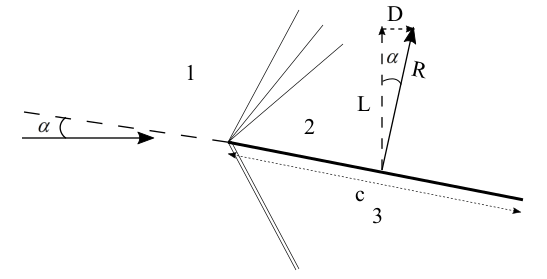Find the lift and wave drag coefficients for an infinitely thin flat plate at an angle of attack of 8^{\circ} in a Mach 3 flow.
Find the lift and wave drag coefficients for an infinitely thin flat plate at an angle of attack of 8^{\circ} in a Mach 3 flow.
 Supersonic flow over a thin flat plate at an angle of attack
Supersonic flow over a thin flat plate at an angle of attack
From the \theta -\beta -M relationship, for \theta = 8^{\circ} and M = 3, \beta =25.611^{\circ}
Therefore,
M_{n1}=M_{1}Sin\beta =3Sin\left ( 25.611^{\circ} \right )=1.297
From normal shock properties, for M_{n1}=1.297, \frac{p_{3}}{p_{1}}=1.796
From isentropic flow properties, for M_{1}=3, \left ( \frac{p_{1}}{p_{01}} \right )=0.02722
From prandtl-Meyer function for M_{1}=3, \nu _{1}=49.76
Therefore, \nu _{2}=\nu _{1}+\theta =49.76^{\circ}+8^{\circ}=57.76^{\circ}
For, \nu _{2}=57.76^{\circ}, M_{2}=3.452
For, M_{2}=3.452, from isentropic flow properties
\left ( \frac{p_{2}}{p_{02}} \right )=0.01404
Therefore,
\frac{p_{2}}{p_{1}}=\left ( \frac{p_{2}}{p_{02}} \right ) \left ( \frac{p_{02}}{p_{01}} \right )\left ( \frac{p_{01}}{p_{1}} \right )=\left ( 0.01404 \right ) \left ( 1 \right )\left ( \frac{1}{0.02722} \right )=0.5158
Total pressure is constant through the expansion wave, p_{02}=p_{01}.
For, a thin flat plate lift per unit span is L{}’=\left ( p_{3}-p_{2} \right )\left ( c \right )cos\alpha
also, c_{l}=\frac{L{}’}{q_{1}S} =\frac{L{}’}{\frac{\gamma }{2}p_{1}M_{1}^{2}c} =\frac{\left ( p_{3}-p_{2} \right )\left ( c \right ) cos\alpha }{\frac{\gamma }{2}p_{1}M_{1}^{2}c} =\frac{2}{\gamma M_{1}^{2}}\left ( \frac{p_{3}}{p_{1}}-\frac{p_{2}}{p_{1}} \right )cos\alpha
\Rightarrow c_{l}=\frac{2}{\left ( 1.4 \right )\left ( 3^{2} \right )}\left ( 1.796-0.5158 \right )cos\left ( 8^{\circ} \right )=0.20123
For a thin flat plate, drag per unit span is D{}’=\left ( p_{3}-p_{2} \right )\left ( c \right )sin\alpha
also,
c_{d}=\frac{D{}’}{q_{1}S}=\frac{D{}’}{\frac{\gamma }{2}p_{1}M_{1}^{2}c} =\frac{\left ( p_{3}-p_{2} \right )\left ( c \right ) sin\alpha }{\frac{\gamma }{2}p_{1}M_{1}^{2}c} =\frac{2}{\gamma M_{1}^{2}} \left ( \frac{p_{3}}{p_{1}}-\frac{p_{2}}{p_{1}} \right )sin\alpha
\Rightarrow c_{d}=\frac{2}{\left ( 1.4 \right )\left ( 3^{2} \right )}\left ( 1.796-0.5158 \right )sin\left ( 8^{\circ} \right )=0.02828




